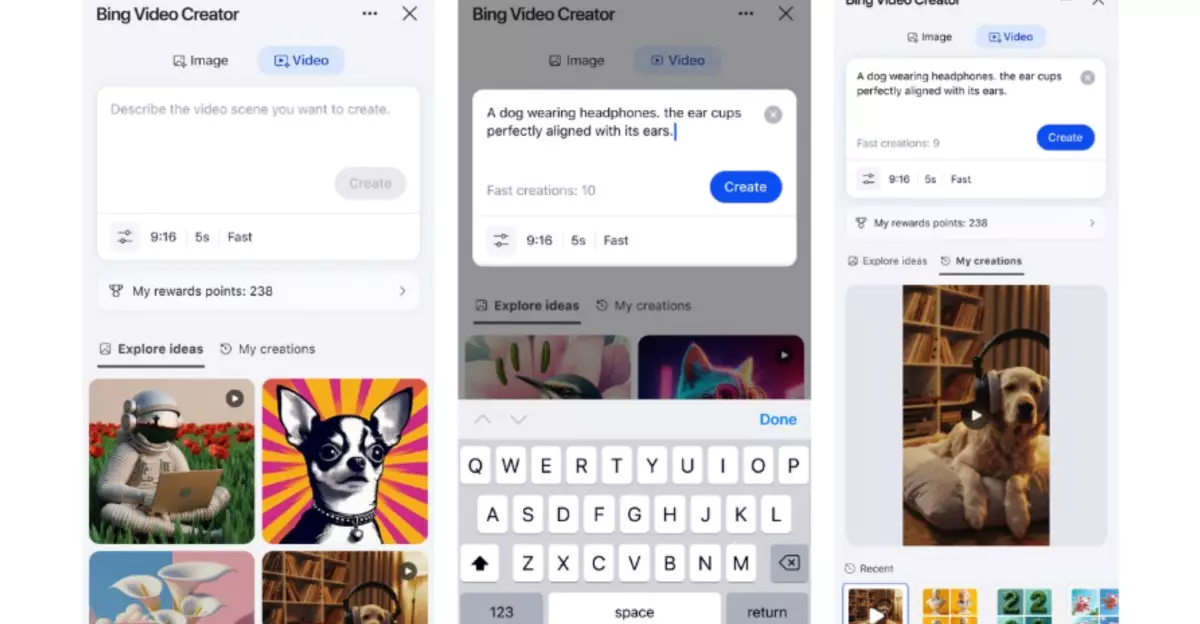In an era increasingly dominated by artificial intelligence, Microsoft is stepping into the limelight with its latest feature in the Bing mobile app: the AI video generator powered by OpenAI’s Sora model. This advancement is not just another tech release but a significant move towards democratizing creative expression through AI. With this tool, Microsoft is aiming to make the transformation of ideas into engaging multimedia content more accessible than ever before, disrupting the traditional barriers that have typically restricted creative tools to those willing to pay a premium.
A Game Changer for Video Creation
The introduction of the Bing Video Creator marks a pivotal moment in the way users can engage with video content. For many, utilizing sophisticated video editing tools often requires a deep understanding of the technology behind them, not to mention financial investment—an obstacle that can deter budding creators. Microsoft’s announcement highlighted its intent to provide a free and user-friendly experience, asserting that “creativity should be effortless and accessible.” This statement underlines the ethos that underpins the Bing Video Creator: a commitment to empower users, regardless of their technical background.
The capacity for generating short video clips with minimal effort serves to integrate the process of content creation directly into the daily lives of users. By merely inputting a description into the search bar or accessing it via the app menu, anyone can produce AI-generated videos, turning written words into visual stories in mere seconds. This ease of use embodies a drastic shift in the landscape of creative industries, wherein tools are becoming increasingly intuitive and efficient.
Features and Limitations of the Tool
The video generator allows users to queue up to three creations at a time and offers two speed options for video generation: standard and fast. While the standard speed is free, the fast option, available for a limited number of uses each day, provides an expedited service that could cater to rapid content creation needs—an appealing feature for influencers and marketers alike. However, the need to redeem rewards points for additional fast generations hints at the potential for monetization, which could impact the equal accessibility Microsoft touts.
Despite its promising capabilities, the initial output quality of the videos generated by the Bing Video Creator raises eyebrows. User experiences indicate that the quality appears cartoonish and lacks fluidity in movements when compared to contenders like Google’s Veo 3. This disparity brings forth questions about Sora’s effectiveness and the viability of Microsoft’s push to dethrone established competitors. While early footage can sometimes misrepresent the full capabilities of a new technology, the roughness observed in Bing’s offerings is a crucial factor to consider for users weighing their options.
The Broader Implications of AI-Driven Creativity
The rollout of an AI video creation tool not only reshapes how individuals produce content but also alters the landscape of the creative industry at large. The democratization of AI tools serves to unleash a wave of fresh creativity, enabling those who may not have had the means or technical know-how to express themselves visually. This paradigm shift could lead to an explosion of diverse content, enriching the internet culture with myriad voices and stories previously unheard.
But it raises larger ethical considerations as well. As AI increasingly infiltrates the creative space, we must grapple with issues such as copyright, authentic representation, and the potential implications for employment within the traditional creative sectors. If technology can simulate creativity, what does that mean for artists and creators who rely on their expertise? The excitement surrounding accessibility must be tempered with caution as we consider the long-term impact of these developments.
A Call to Action for Users
For individuals eager to explore the possibilities this technology brings, the Bing Video Creator presents an enticing opportunity. It invites users to delve into creative experimentation, to play with narratives and visual storytelling in ways previously constrained by many factors. As Microsoft rolls this tool out globally, excluding a few countries, users should seize the chance to engage with it, providing feedback to help improve the technology while harnessing newfound creative powers.
The integration of AI into our creative processes signifies a pivotal shift, and users are encouraged to actively participate in shaping this unfolding narrative. One thing is certain: as technology rapidly evolves, so too does the potential for creativity. Today marks the beginning of a new chapter where anyone can turn words into visual wonder.

